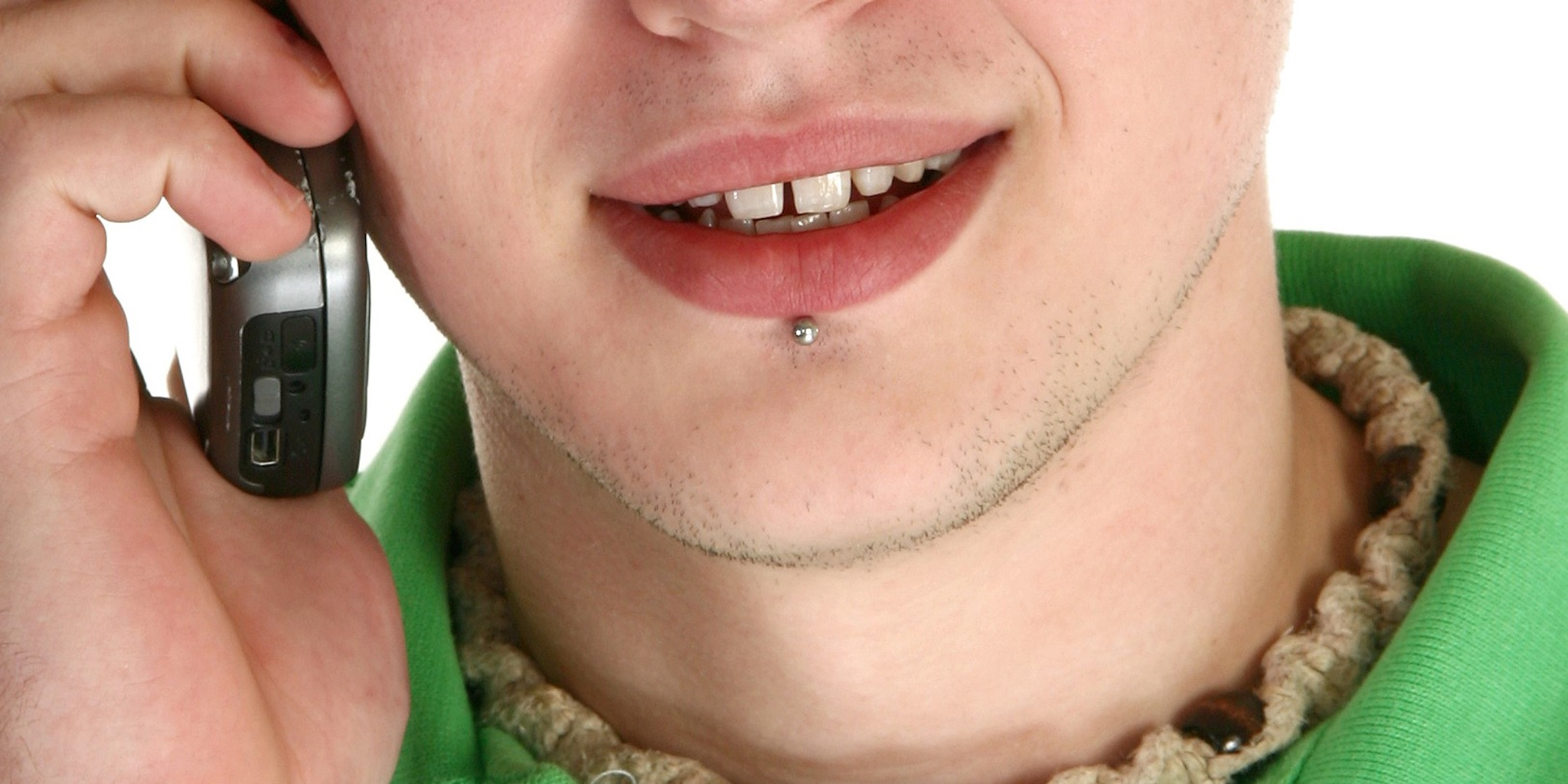
Labret Piercing Explained: Facets Of A Chic Face Piercing
Labret Piercing Article Quick Reference:
History | Myths | Complications | Pain | Cost | Procedure | Healing | Aftercare | Jewelry | Celebrities
The allure of body modification has captivated human cultures for centuries, and among its diverse expressions is the labret piercing—a unique and striking form of self-expression. Situated below the lower lip, just above the chin, the labret has roots in ancient civilizations, where it signified status, beauty, and identity.
However, diving into the world of labret piercings involves more than just choosing a style. It is a journey that encompasses understanding its rich history, considering the risks, the piercing procedure itself, the financial investment, and, crucially, the healing and aftercare process.
In this article, we will navigate through the intriguing past of labret piercings, shedding light on how this ancient practice has evolved into a modern fashion statement. We will delve into the practical aspects, too—what to expect during the piercing procedure, the potential risks and how to mitigate them, and the varying cost factors. Most importantly, we’ll guide you through the critical healing phase, offering expert advice on aftercare to ensure your labret piercing heals beautifully and remains an adornment you can cherish for years to come. You will even learn about the best jewelry to wear in a labret piercing.
Whether you’re considering a labret piercing for the first time or looking to deepen your knowledge about this unique form of body art, this comprehensive exploration offers everything you need to know, and more.
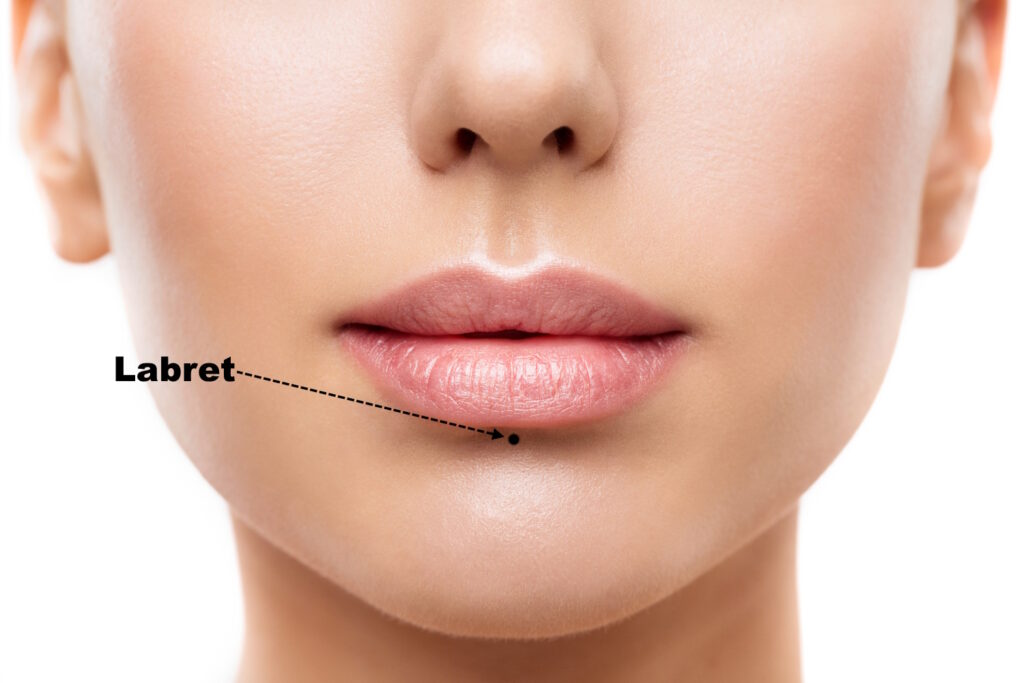
A SHORT HISTORY OF THE LABRET
Various cultures and time periods have woven the tapestry of labret piercing history, each adding its own significance and style to this unique form of body adornment.
The labret piercing has ancient roots, with evidence of its practice dating back as far as 3000 BC. Among the earliest known examples were the Aztec and Maya civilizations in Mesoamerica, where labret piercings had deep cultural and religious significance. In these societies, piercings were often made using gold, jade, or obsidian, and were indicative of high social status or religious roles.
Similarly, in some African and American Northwest Coast tribes, labret piercings were prevalent and symbolized various social standings. For instance, among the Makololo tribe of Malawi, a labret piercing indicated a woman’s marriageable status. In the Arctic regions, the Inuit used labret piercings as a rite of passage for young women.
The exploration and colonization periods brought Westerners into contact with these indigenous practices, leading to a mix of fascination and, at times, misunderstanding.
In the 20th century, particularly towards the latter half, the piercing and body modification movement in Western societies began to embrace labret piercings, along with other forms of body art that had ancient roots in other cultures.
In modern times, particularly from the 1990’s onwards, the labret piercing has seen a surge in popularity in the Western world, evolving from a cultural or religious symbol to a form of individual self-expression and fashion statement.

LABRET PIERCING MYTHS
There are several myths and misconceptions about labret piercings. Here are a few common ones:
- Labret Piercings Are Extremely Painful: While any piercing involves some discomfort, the pain associated with a labret piercing is typically manageable and brief. It varies from person to person.
- Labret Piercings Are Unprofessional: The perception of professionalism varies across different industries and workplaces. Some employers may have policies against visible piercings, while others may not mind them at all. It’s essential to consider your workplace’s policies and culture before getting a labret piercing.
- Labret Piercings Always Get Infected: With proper care and hygiene, you can heal labret piercings without infection. However, like any wound, there is a risk of infection if not adequately maintained.
- Labret Piercings Can’t Be Removed: You can remove labret jewelry for cleaning, replacement, or if you decide to take it out permanently. It’s crucial to consult with a professional piercer to ensure proper removal.
- Labret Piercings Are Only For A Certain Gender: Piercings serve as a form of self-expression and do not limit themselves by gender. Anyone can choose to get a labret piercing if they desire it.
Always consult with a professional piercer and follow their aftercare instructions to minimize risks and ensure a successful healing process for your labret piercing.
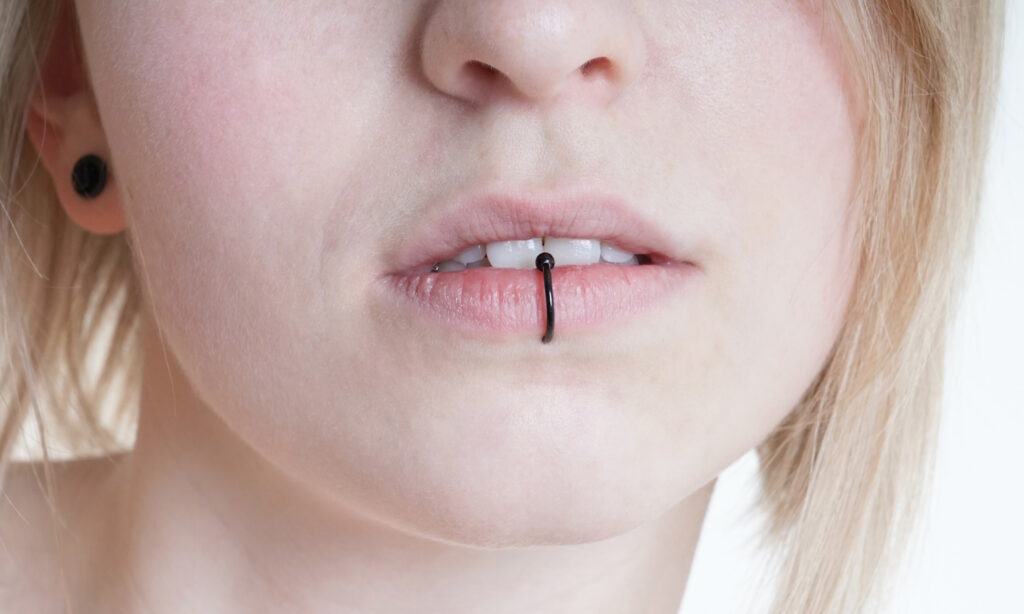
THE POPULARITY OF LABRET PIERCINGS
The popularity of labret piercings can vary based on gender and age groups, but it’s important to note that trends and preferences can change over time and may differ by region and culture. Here’s a general overview:
- Gender: Individuals of all genders wear labret piercings, and their popularity isn’t heavily skewed toward one gender over another. It’s a versatile piercing choice appealing to a wide range of people.
- Age: Labret piercings are popular among various age groups, but their prevalence might differ. Younger individuals, such as teenagers and young adults, may be more inclined to get labret piercings as part of their self-expression and fashion choices. Older age groups may have lower rates of labret piercings. This, of course, can vary depending on personal preferences and cultural factors.
Keep in mind that individual preferences for piercings can vary widely. Also, the popularity of labret piercings can change over time. It’s always best to consult with a professional piercer and make choices based on your personal style and preferences rather than solely on trends or demographics.
THE RISKS OF GETTING LABRETS
A labret piercing, which is a piercing below the lower lip above the chin, can have several risks and complications:
- Infection: Piercings can become infected, especially if you use non-sterile piercing equipment or fail to properly care for the piercing afterwards.
- Swelling And Bleeding: Swelling is common after any piercing, but excessive swelling can be problematic. Bleeding is also a risk, especially if a blood vessel gets punctured during the piercing.
- Allergic Reactions: Some people may have allergic reactions to certain metals used in the jewelry.
- Damage To Teeth And Gums: Labret piercings can rub against the gums and teeth, potentially leading to gum recession, tooth enamel wear, or cracked teeth.
- Nerve Damage: While rare, there is a risk of nerve damage which can lead to numbness or loss of sensation in the area.
- Difficulty In Healing: Oral piercings, in general, can be slow to heal and are prone to infection due to the bacteria in the mouth.
- Scarring: Any piercing can lead to scarring, including hypertrophic scarring or keloids, particularly if the piercing does not heal properly.
- Jewelry Displacement Or Rejection: The body might push the jewelry out (rejection) or the jewelry can move from its original position (migration).
It’s crucial to follow all aftercare instructions provided by the professional who performs the piercing and to seek medical advice if you notice signs of infection or other complications.
THE COMPLICATIONS
Before getting a labret piercing, it’s also important to consider certain health conditions that might increase the risk of complications including:
- Oral Health Issues: If you have gum disease, frequent cavities, or other dental issues, a labret piercing could exacerbate these problems due to constant contact with oral tissues.
- Blood Clotting Disorders: Conditions like hemophilia or a history of blood clots can increase the risk of excessive bleeding during and after the piercing.
- Diabetes: This condition can impede healing and increase the risk of infection. It’s crucial to have well-controlled diabetes before considering any piercing.
- Immune System Disorders: If you have an immune deficiency, whether due to a condition like HIV/AIDS or to medications (such as immunosuppressants), you’re at a higher risk of infection.
- Heart Conditions: Healthcare providers may advise individuals with certain heart conditions to take antibiotics before getting a piercing to prevent bacterial endocarditis.
- Skin Disorders: Conditions like eczema or psoriasis near the piercing site can affect healing.
- Medications: Certain medications, especially those that affect the immune system or blood clotting, can impact the healing process.
It’s always a good idea to consult with a healthcare provider before getting a piercing if you have existing health concerns. They can provide personalized advice based on your medical history.
WHAT SHOULD I DO IF I NO LONGER WANT MY LABRET PIERCING?
If you decide you no longer want your labret piercing, here are the steps you can follow:
- Remove The Jewelry: The simplest way to get rid of a piercing is to remove the jewelry. Make sure your hands are clean to prevent introducing bacteria into the area.
- Allow For Natural Healing: Once you remove the jewelry, the hole will start closing on its own.The time it takes for the hole to close can vary depending on how long you’ve had the piercing and your body’s healing process.
- Monitor For Infection: Even after removing the jewelry, it’s important to watch for signs of infection, such as redness, swelling, pain, or discharge.
- Continue Piercing Care: Continue to clean the area gently with a saline solution or as advised by a professional until the hole has closed and healed.
- Scar Treatment: If you’re concerned about scarring, there are several over-the-counter treatments you can use. These include silicone scar sheets or gels. For more pronounced scarring, you might want to consult a dermatologist.
- Avoid Re-piercing Until Fully Healed: If you decide you want another piercing in the same area in the future, wait until the area has completely healed before getting re-pierced.
Remember, each person’s body reacts differently, so healing times and processes can vary. If you have any concerns or if the area shows signs of infection, consult a healthcare provider.
IS THE LABRET PIERCING PAINFUL?
The pain experienced during a labret piercing can vary greatly from person to person, as pain tolerance is highly individual. Generally, people report a sharp pain or pinch during the actual piercing, which is usually quick. Some discomfort and throbbing might follow in the hours after the piercing.
Factors that can affect the level of pain include:
- Individual Pain Threshold: Some people have a higher tolerance for pain than others.
- Experience With Piercings: Those who have had other piercings may find it less painful due to familiarity with the sensation.
- Technique And Skill Of The Piercer: A professional and experienced piercer can make the process less painful.
- State Of Mind And Relaxation: Being anxious or tense can increase the perception of pain, while being relaxed can reduce it.
It’s important to remember that the piercing process is relatively quick, and any acute pain is usually short-lived. If you’re concerned about the pain, discussing it with a professional piercer can help as they can provide more detailed information and reassurance.
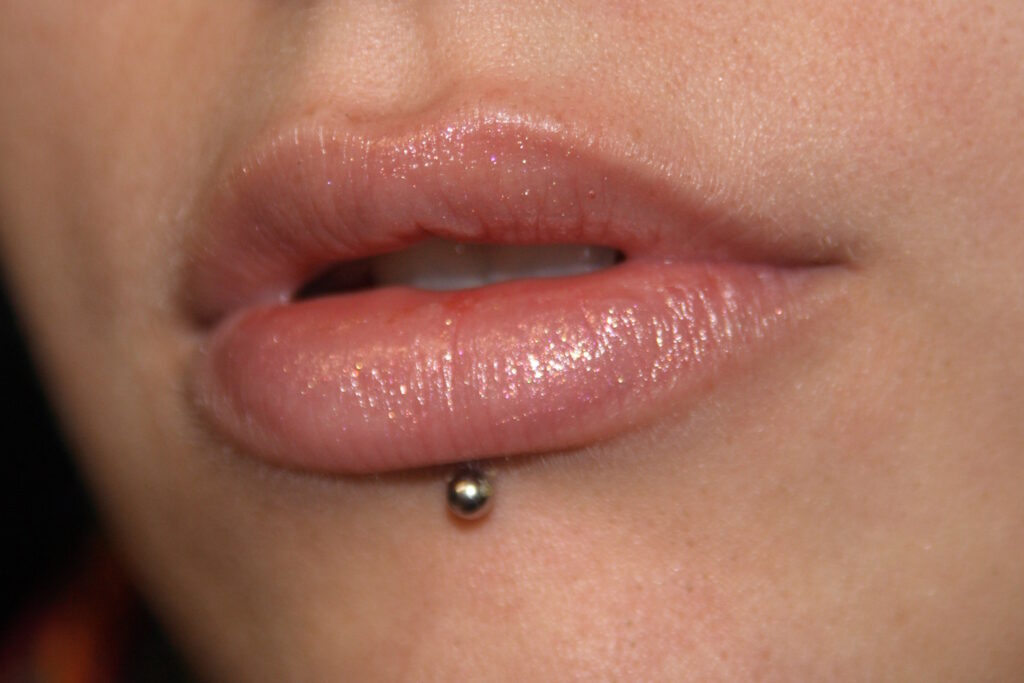
HOW EXPENSIVE IS THE LABRET PIERCING?
The cost of a labret piercing can vary significantly depending on several factors. These include the location of the piercing studio, the experience and reputation of the piercer, the type of jewelry you choose, and regional differences in pricing. Here’s a general idea of what you might expect in different regions of the United States:
- Midwest: In the Midwest, the cost of a labret piercing can range from around $30 to $70. Prices may be higher in larger cities like Chicago.
- East Coast: On the East Coast, especially in major cities like New York or Boston, prices can be higher due to the higher cost of living. You might expect to pay anywhere from $40 to over $80.
- West Coast: On West Coast cities like Los Angeles or San Francisco, the cost can similarly range from around $40 to $80 or more, reflecting the higher cost of living and the popularity of piercings in these areas.
- South: In the southern states, the cost can be a bit lower, possibly ranging from $30 to $60, but this can vary widely depending on the exact location and the specific piercing studio.
Remember, the cheapest option is not always the best when it comes to body modifications. It’s crucial to ensure that the piercing studio is clean, reputable, and adheres to all safety standards.
Also, the type of jewelry you select (material, quality, brand) can significantly affect the price. High-quality, hypoallergenic materials like titanium or surgical steel may cost more but are generally safer and better for healing.
It’s always a good idea to research and even visit a few piercing studios to get a sense of their prices. You can also check quality of their work, and their safety practices before making a decision.
GET READY FOR THE LABRET PIERCING PROCEDURE
The normal size, or gauge, of a labret piercing, typically ranges from 16 gauge (1.2mm) to 14 gauge (1.6mm) when initially pierced.
The labret piercing procedure involves several key steps, from preparation to the actual piercing and aftercare instructions. Here’s a detailed guide:
- Pre-Piercing Consultation
- Consultation With The Piercer: Discuss your desired placement, jewelry options, and any health concerns. The piercer should inform you about the procedure.
- Select Jewelry: Choose the appropriate jewelry for your initial piercing.
- Preparation For Piercing
- Clean The Area: The piercer will clean the outside of your lip area with an antiseptic solution to minimize the risk of infection.
- Marking The Spot: The piercer will mark the exact spot where the piercing will be made. This is usually with a surgical marker. You’ll get a chance to approve the placement.
- The Piercing Process
- Positioning: You will be asked to sit or recline in a position that allows the piercer easy access to the piercing site.
- Gloves And Safety: The piercer will wear sterile gloves for the entire procedure.
- Clamping: A clamp may be used to hold the lip steady and to provide a guide for the needle.
- Piercing: Using a sterilized, hollow needle, the piercer will quickly and precisely puncture the marked spot. The needle may be inserted from the outside of the lip inward or vice versa, depending on the specific type of labret piercing.
- Inserting The Jewelry: Immediately after the needle, the jewelry is inserted into the hole.
- Cleaning: The area is cleaned again to remove any blood or bodily fluids.
- Schedule A Follow-Up: Some studios recommend a follow-up visit to check on the healing process.
Remember, every piercing studio and piercer may have slight variations in their procedure, but overall, these are the common steps.
WHAT’S THE HEALING TIME?
The healing time for a labret piercing can vary depending on several factors. These factors include individual health, aftercare practices, and the body’s natural healing process. Generally, the timeline can be broken down as follows:
- Initial Healing Phase: This phase usually lasts for about 6 to 8 weeks. During this time, the body starts to heal the wound created by the piercing. It’s normal to experience swelling, redness, and some discomfort in the first few days. Proper aftercare during this phase is crucial to prevent infection and promote healing.
- Intermediate Healing Phase: This phase can last several months, often up to 6 months. In this stage, the piercing may seem healed from the outside, but the tissue inside is still repairing. The risk of infection is lower, but good hygiene and aftercare practices are still important.
- Full Healing Phase: A labret piercing can take anywhere from 3 months to a year to fully heal. The wide range in healing time is due to individual differences in healing and the care taken during the healing process.
It’s essential to follow the specific aftercare instructions provided by your piercing professional. Also, you can, consult with them or a healthcare provider if you have concerns about the healing process.
TAKING CARE OF THE LABRET
Taking care of a labret piercing is crucial for ensuring proper healing and preventing infection. Here’s a comprehensive guide to labret piercing aftercare:
- Initial Care (First Few Weeks)
- Keep the Area Clean: Gently clean the piercing twice a day with a saline solution. Also you may use antiseptic mouthwash if instructed by your piercer. Avoid over-cleaning as it can delay healing.
- Avoid Touching The Piercing: Only touch the piercing with clean hands when necessary. Avoid unnecessary movement of the jewelry.
- Oral Hygiene: Maintain good oral hygiene to prevent infection. Use an alcohol-free antiseptic mouthwash after eating, drinking, or smoking.
- Rinse With Saline Solution: For the external part of the piercing, use a saline solution. You can buy a pre-made solution or make your own by dissolving 1/4 teaspoon of non-iodized sea salt in a cup of warm distilled or bottled water.
- Avoid Irritants: Stay away from alcohol, spicy foods, and tobacco, as these can irritate the piercing.
- Eat Carefully: Choose soft foods and chew slowly to avoid irritating the piercing.
- Ongoing Care
- Avoid Makeup And Lotions: Keep cosmetics, lotions, and sprays away from the piercing site.
- Check Jewelry Regularly: Ensure the jewelry is secure but avoid unnecessary manipulation.
- Avoid Swimming Pools: Chlorinated water can irritate the piercing, so avoid bodies of water. This includes swimming pools, hot tubs, and natural bodies of water during the initial healing phase.
- Be Careful With Clothing And Bedding: Ensure that your clothing or bedding does not snag on the piercing.
- Monitor For Signs Of Infection: Watch for excessive redness, swelling, pain, or discharge. Seeek medical advice if these symptoms occur.
- Sleeping Position: Try to avoid sleeping on the piercing to reduce pressure and potential irritation.
Remember, healing times can vary, and it’s important to follow any specific advice given by your piercer.
UPDATING YOUR JEWELRY
The timing for changing the starter jewelry of a labret piercing depends on how well your piercing is healing. Generally, it’s advisable to wait until the piercing is fully healed before changing the jewelry. Here are some guidelines:
- Typical Healing Time: Labret piercings typically take about 6 to 8 weeks to heal initially. This estimate can vary from person to person though. Some piercings may require up to several months for complete healing.
- Signs Of Healing: Look for signs that the piercing has healed. These include the absence of redness, swelling, pain, and discharge. The area around the piercing should feel comfortable and pain-free.
- Consultation With A Professional: Have your piercing checked by a professional piercer before changing the jewelry. They can assess whether it’s healed enough and can assist with the first change to ensure it’s done safely.
- Be Gentle And Hygienic: When changing the jewelry, make sure your hands are clean. Also, make sure to be gentle with the piercing to avoid causing any trauma to the area.
It’s important not to rush this process. Changing the jewelry too early can irritate the piercing, potentially leading to infection or prolonging the healing time. If you experience any problems after changing the jewelry, such as irritation, redness, or swelling, consult with a professional.
JEWELRY MATERIALS FOR THIS PIERCING
When choosing jewelry for a labret piercing, selecting the right material is crucial for both healing and long-term comfort. Here are some of the best materials to consider:
- Surgical Stainless Steel: This is one of the most common and safe materials for initial piercings and healed piercings. It’s durable, generally safe for those with allergies, and less likely to cause a reaction.
- Titanium: Titanium is a high-quality material that is hypoallergenic and often recommended for people with metal sensitivities. It’s lightweight and can come in various colors through anodization.
- Niobium: Similar to titanium, niobium is hypoallergenic and can be anodized for color. It’s a bit heavier than titanium but is still a good option for those with sensitivities.
- Solid Gold: If choosing gold, opt for 14K or 18K to avoid potential irritations. Gold less than 14K can contain alloys that might irritate a new piercing. It’s important to make sure it’s solid gold and not gold-plated, as plating can wear off and expose underlying metals.
- Biocompatible Polymers (e.g., Bioplast, PTFE): These materials are flexible, hypoallergenic, and can reduce the risk of injury to the teeth or gums, making them a good choice for oral piercings like labrets.
Many people are allergic to nickel, a common alloy in cheaper metals. Avoid jewelry that contains nickel. Invest in good-quality jewelry for your piercing. Cheaper materials may cause irritation, allergic reactions, or other complications.
Consult with your piercer about the best material for your individual needs, especially if you have metal sensitivities or allergies. They can guide you toward the most suitable choice for both initial piercing and long-term wear.
JEWELRY TYPES FOR THIS PIERCING
Several types of body jewelry are commonly used for a labret piercing. These are recommended for both comfort and style:
- Labret Stud: These represent the most common types of jewelry used for labret piercings. They consist of a straight barbell with a flat disc on one end. On the front end, there is usually a decorative piece. The flat disc sits comfortably against the inside of the mouth, reducing irritation to the gums and teeth.
- Circular Barbells (Horseshoe Rings): You can wear these horseshoe-shaped barbells in labret piercings. They have a ball or spike on each end, and the open design allows for some movement.
- Captive Bead Rings (CBR): The tension of the ring holds a small bead in place on these rings. They can be a bit more challenging to insert and remove but are popular for their sleek look.
- Seamless Or Segment Rings: These are smooth, circular rings that give a more continuous and seamless appearance. They can be trickier to open and close but offer a very clean and minimalistic look.
When choosing jewelry for a labret piercing, it’s important to consider the size (gauge and length). Choose a quality material to ensure comfort and minimize the risk of irritation or allergic reactions.
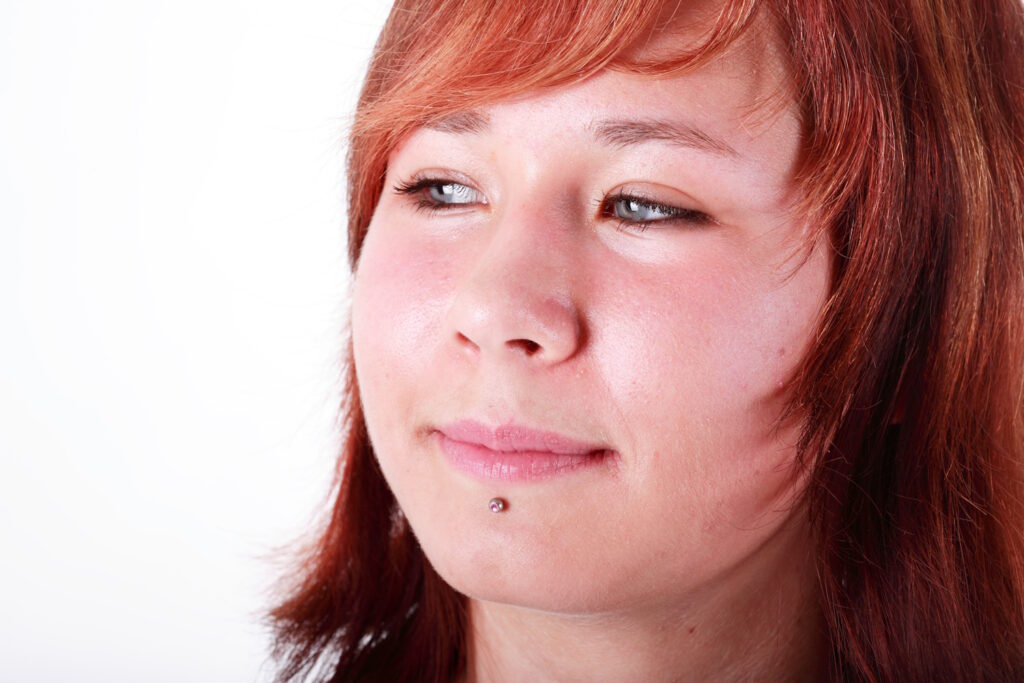
ARE THERE ANY CELEBRITIES WITH LABRETS?
Several celebrities sometimes sport labret piercings at different times. Here are seven of them:
- Alyssa Milano: Known for her roles in “Charmed” and other TV series, Milano has sported a labret piercing.
- Travis Barker: The famous drummer of Blink-182 has had various facial piercings, including a labret.
- Dave Navarro: The guitarist from Jane’s Addiction and former member of Red Hot Chili Peppers has been seen with a labret piercing.
- Christina Aguilera: In the early 2000s, she experimented with various piercings, including the labret.
- Lenny Kravitz: This rockstar is known for his bold style choices, which have included a labret piercing.
- Tommy Lee: The Mötley Crüe drummer has been known for his heavily pierced look, including a labret piercing.
- Joel Madden: The lead vocalist for Good Charlotte, Madden has been spotted with a labret piercing.
Remember, celebrities often change their style, and piercings can be temporary or permanent, so their current looks might differ from past styles.
ARE YOU READY TO GET A LABRET?
The labret piercing is a distinctive and versatile form of body modification that holds both historical significance and contemporary appeal. From its origins in ancient cultures to its modern-day variations, the labret piercing has evolved into a statement of personal style and self-expression. As we have explored, the choices in jewelry types offer individuals the freedom to customize their look to suit their personal aesthetic and lifestyle.
It’s important to remember that the success of a labret piercing largely depends on proper aftercare and hygiene practices. Ensuring the use of high-quality, suitable jewelry and adhering to a diligent cleaning regimen are crucial steps in promoting healing and preventing complications. Additionally, considering the size and placement of the piercing by consulting with a professional piercer can significantly impact both the healing process and the overall appearance of the piercing.
Whether seeking to make a bold fashion statement or to subtly enhance one’s features, the labret piercing provides a unique opportunity to do so. With its rich history, variety of styles, and the ability to be both bold and understated, the labret piercing remains a popular and compelling choice for those interested in body art. As with any form of body modification, it’s a personal journey and should be approached with care, thoughtfulness, and a sense of individuality.
Need to find a piercer? Check out the Association of Professional Piercers.
Author: Scott S.
